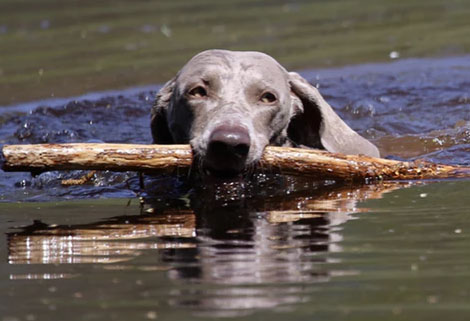a fresh water warning
by Elliott Berry
 As some of you may know I contracted Leptospirosis in May 2014 and although I didn’t really want to write this article and elicit sympathy from anyone and have avoided writing it for a few years, I felt that now was the time especially with the increase in vessels being converted into houseboats.
As some of you may know I contracted Leptospirosis in May 2014 and although I didn’t really want to write this article and elicit sympathy from anyone and have avoided writing it for a few years, I felt that now was the time especially with the increase in vessels being converted into houseboats.
I was called to a vessel that was apparently sinking in the River Medway.
Upon arrival at the vessel it was clear that the vessel was in fact afloat still but had a large volume of water in the after cabins. My first response was to ascertain whether the water was indeed from an external source i.e river water or from an internal source i.e. a fresh water leak.
As I had done many times previously I conducted simple taste test and quickly ascertained that it was in fact “fresh” water. I then examined the vessel’s water system and found that all piping was still well installed and properly connected and that the water tank was in good order with no sign of leaks, a mystery indeed.
I advised the owner to pump out the water and to keep the area under observation and to call me if any further water were to appear. After six or seven days I had heard nothing.
During the next couple of days, I had been doing some work in the garden at home and started to feel unwell but initially I put that down to having overdone it. Over the next few hours I started to feel weak and developed a serious headache, at this point I rang the doctor and made an appointment. Initially the doctor intimated that it may be meningitis but that as I had no rash or sensitivity to light was quickly dismissed. The advice was to go home, drink lots of water and take paracetamol and to return in a few days if the symptom persisted.
Unusually for me I followed the doctor’s orders but the weakness and headache became progressively worse and I developed uncontrollable shivering and so a visit to the Accident and Emergency department ensued upon which it was decided that I had contracted hepatitis A and should go home, drink lots of water and take paracetamol.
That night my wife became increasingly concerned as I had developed a fever so a further visit to hospital was undertaken. Upon arrival, it was clear to the doctors that something was seriously wrong and I was admitted immediately and placed on a saline drip.
The next few hours are a bit of a blur but a huge number of blood tests, CT scans and ultrasounds were carried out and initially nothing was diagnosed although the blood tests showed that my liver had extremely elevated readings.
I was given numerous antibiotics and liquid paracetamol over a 24 hour period but the 41 degree fever would not subside, to the point that it was clear that my life was at risk.
A series of different medications were administered to me and, after eight days in hospital, I had recovered sufficiently to return home although at that point nothing had been officially diagnosed and the only possible suggestion to fit the symptoms was leptospirosis despite not showing up in blood tests.
After a further three weeks convalescing, I was able to return to work and some investigation into what may have caused the illness was undertaken.
As it turned out, the vessel in question had been converted to a houseboat some twenty years previously and the bilges were cleaned out but, instead of disposing of the contents properly, the liquid and debris were placed into one of her ballast tanks. The tank had subsequently corroded from the inside and had deposited its contents into the aft cabin ready for an unsuspecting surveyor to taste it. Obviously, the true contents of the water are unknown but I can assure you that I no longer undertake taste tests on water and advise that no one else does the same.
In order to prevent anyone suffering the same as I did, I thought it prudent to highlight the dangers faced when working in or around water.
Introduction to Leptospirosis
Leptospirosis is a bacterial infection caused by certain members of the genus leptospira.
 Most people who develop a leptospirosis infection only get mild symptoms but a bit more serious influenza- like symptoms are also quite common. In a minority of infected persons, leptospirosis develops into the dreaded Weill’s disease. Weill’s disease is a serious condition that can involve liver failure, kidney failure, meningitis and sepsis. Weill’s disease can be fatal.
Most people who develop a leptospirosis infection only get mild symptoms but a bit more serious influenza- like symptoms are also quite common. In a minority of infected persons, leptospirosis develops into the dreaded Weill’s disease. Weill’s disease is a serious condition that can involve liver failure, kidney failure, meningitis and sepsis. Weill’s disease can be fatal.
Weill’s disease is caused by leptospira interrogans belonging to the serogroup Icterohaemorrhagiae or Pomona. A person who develops Weill’s disease will usually have gone through influenza like symptoms of leptospirosis for a week or so and seemingly be well on their way to recovery. After a short period of no symptoms or only mild symptoms, the person gets very ill with symptoms of poor liver function, poor kidney functions, meningitis and/or sepsis. The lethality for Weill’s disease is 5% – 10%.
Transmission
Urine and blood from a leptospirosis infected person or animal can contain a sufficient amount of bacteria to spread the disease. A common transmission route for humans is getting urine or blood from an infected animal on damaged skin. Even a tiny skin abrasion can be enough for the bacteria to get into the body. Leptospira bacteria can also enter the body through mucous membranes, e.g. those found in the eyes, nose, mouth and genitals.
 When infected blood or urine gets into water or soil, the bacteria can survive there for several months.
When infected blood or urine gets into water or soil, the bacteria can survive there for several months.
Many different animals can carry and transmit leptospirosis, including dogs, rodents, cattle, horses and pigs. An infected animal is often symptom free and can continue to excrete bacteria into the environment year after year.
The incubation time for leptospirosis in humans is usually one to two weeks but anywhere from 48 hours to more than a month has been reported.
Symptoms
Examples of symptoms from the eyes
- Eye inflammation can occur, with reddening of the eyes and increased sensitivity to light.
- If leptospirosis bacteria causes liver inflammation with poor liver function as a result, one noticeable symptom can be the yellowing of the sclera. The sclera is the white part of the eye; the part that surrounds the iris. When the liver isn’t working properly, the sclera becomes yellow due to increased levels of bilirubin in the body. In some cases, the sclera can even look greenish. Always check your eyes before you put in your contact lenses if you wear colored lenses. If you do not you risk not seeing the symptoms of leptospirosis, liver damage and a long row of different diseases.
Examples of symptoms from the skin
- Skin rash
- If leptospirosis bacteria causes liver inflammation with poor liver function as a result, symptoms can include the yellowing of the skin due to increased levels of bilirubin. In such situations, itchy skin is also common. In severe cases, the skin can look greenish rather than yellowish.
Examples of symptoms from the digestive system
- Stomach ache
- Diarrhea
- Vomiting
- If leptospirosis bacteria causes liver inflammation with poor liver function as a result, symptoms can include pale faeces and dark urine.
Examples of symptoms from the respiratory system
- Coughing up blood (caused by lung bleeding)
Examples of other symptoms
- High fever
- Chills
- Headache
- Muscle ache
Edema Treatment
Leptospira bacteria are sensitive to several different antibiotics, including well-known ones such as Penicillin and Doxycycline.
If the infection is diagnosed early and symptoms are mild, oral antibiotics are often sufficient. In more severe cases, intravenous treatment with antibiotics may be necessary. Each individual symptom can also require specific treatment. If kidney function is impaired, dialysis can be carried out.
When an MD has good reason to suspect leptospirosis in a patient, antibiotic treatment is typically started right away, without waiting for test results.
How quickly can an illness develop?
Human leptospirosis takes a while to incubate, and the normal range between exposure and illness is 3 to 14 days, although it can take up to 21 days. It’s considered extremely unlikely that the illness would show earlier than 24 hours after exposure, even if the patient was otherwise unwell. In rare cases the incubation time can be very long (several weeks) but we normally assume that if there is no illness after 30 days then infection is either not present, or was subclinical.
Illness that develops within 12 hours of the exposure event would not be leptospiral in origin. Often infections that involve contaminated water can show illness very rapidly, caused by the effects of other unrelated bacteria and viruses in the water (such as E.coli or cryptosporidium) or from some chemicals, and while these would not in themselves normally be life-threatening, they can mask the later symptoms of leptospirosis.
The incubation time depends on the strain of bacteria involved, as some strains reproduce faster in human blood than others, but the main factor is the size of the ‘inoculum’ – the dose of bacteria that entered the patient during their exposure. Although it’s perfectly possible to be infected from a single bacterium, in reality the illness develops because the rate that the bacteria are reproducing is faster than the patient’s immune system can control. Bacteria grow by splitting in half, so one becomes two, two become four, and so on. If the patient received a large number of bacteria from the initial contact then the numbers in their bloodstream will be larger, and increase faster – hence the illness develops sooner.
It’s very difficult to predict the incubation time in a patient, but in very general terms the concentration of bacteria in the inoculum will be important (water from a large clean river will have many times less bacteria per litre than urine direct from a rat) and the volume that enters the body (infection via small cuts to the skin usually involve very small volumes of liquid, but swallowing water after a fall into a lake will of course involve far more. The balance of course is that the situations where patients suffer a high-volume intake are usually those where the liquid has a low concentration (you are unlikely to fall into a tank of rat urine).
Precautions against infection
To minimise the chances of infection, the only truly effective way is to avoid contact with contaminated water and animals, thus avoiding exposure to the bacterium. If you are in a high risk area, you should always attempt to minimise contact, as there are many hundreds of other organisms that can lurk in the water apart from Leptospira. Unless you are required to enter the water, you should stay away from it. Animals themselves present a risk while infected, as their body fluids can contain the bacteria.
Water
The vast majority of human cases are from contaminated water, and of those the majority are occupational cases from areas of the world where agriculture and rodents mix – rice-farming, cane-growing and so forth. Recreational exposure is next, with cases amongst swimmers being the obvious top grouping. Lowest of the risk groups is occupational exposure in the developed world – water and sewer engineers, construction, pest control and so on.
Clearly there are problems in preventing exposure in the highest risk activities (rice-farming and such) and in those areas the only option is to be aware of symptoms and seek early treatment. At this time there is no universally-agreed human vaccine, and the preventative use of antibiotics can only be considered for short periods.
Swimming is the greatest risk, and several cases are reported each year from swimming in contaminated water (both in the developed world and in activities such as adventure racing). There is no practical way to prevent exposure as some water will always enter the mouth. For one-off activities such as expeditions there is an argument for using a preventative antibiotic (doxycycline) which can offer increased resistance to illness for a few weeks. It should never be used long-term.
 Anglers and bankside/sewer workers should wear splashproof clothing and expecially gloves. Anglers are at higher risk as it is reasonably common to cause minor cuts with hooks, knives and the like, and this greatly increases the ease by which the bacteria can enter the body. Fish caught from suspect areas should of course never be eaten. Whilst cooking does in theory kill any bacteria within a fish, very often the level of cooking is insufficient to guarantee safety.
Anglers and bankside/sewer workers should wear splashproof clothing and expecially gloves. Anglers are at higher risk as it is reasonably common to cause minor cuts with hooks, knives and the like, and this greatly increases the ease by which the bacteria can enter the body. Fish caught from suspect areas should of course never be eaten. Whilst cooking does in theory kill any bacteria within a fish, very often the level of cooking is insufficient to guarantee safety.
Recreational exposure (swimming, skiing, sailing, caving, etc) is clearly done at the person’s own risk and they must weigh up their own balance of risk vs. desire. The same preventative measures apply – minimise the risk of water entering the body by any and all means, consider antibiotics if the risks are very high, and be aware of the symptoms and seek treatment immediately. There are no ‘quick fixes’ to prevent infection. Some swimmers wash their mouths with antibacterial rinse, though this has not been proved to offer any significant benefit other than keeping their teeth clean.
Scuba divers, who are particularly at risk, should opt for drysuits and try as much as possible to avoid swallowing any water when purging or changing regs. Commercial divers are required by their employment regulations and insurance to comply with strict rules when working in contaminated water, these include the use of hard-hat systems, wash-down stations and regular medical testing.
Remember that this advice applies to FRESH water – the risks in saltwater are virtually zero.
 Elliott Berry is the owner of Marsurv, Independent Marine Surveyors and Consultants, and is himself an independent Marine Surveyor/Naval Architect & Consultant.
Elliott Berry is the owner of Marsurv, Independent Marine Surveyors and Consultants, and is himself an independent Marine Surveyor/Naval Architect & Consultant.
This article was first produced for and published by The Report in June 2017
Call: 0844 567 7709 / 07500 881731; Visit website or write
